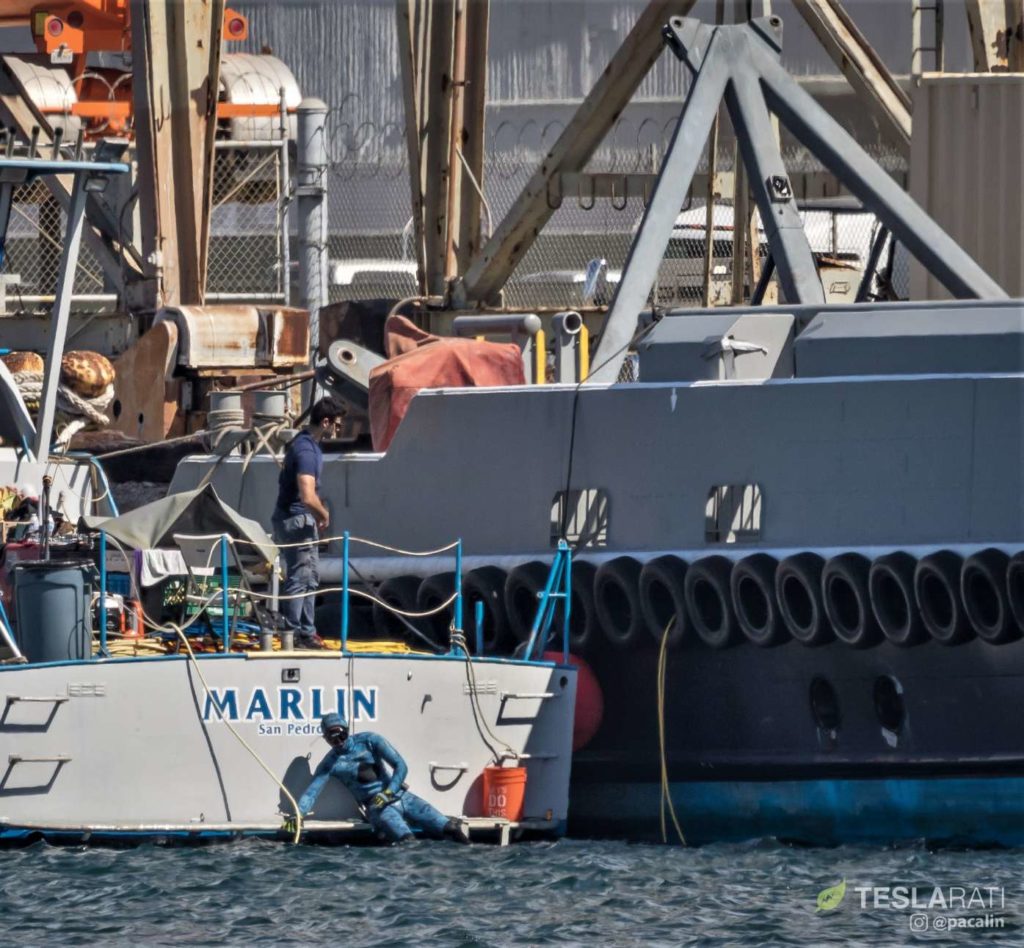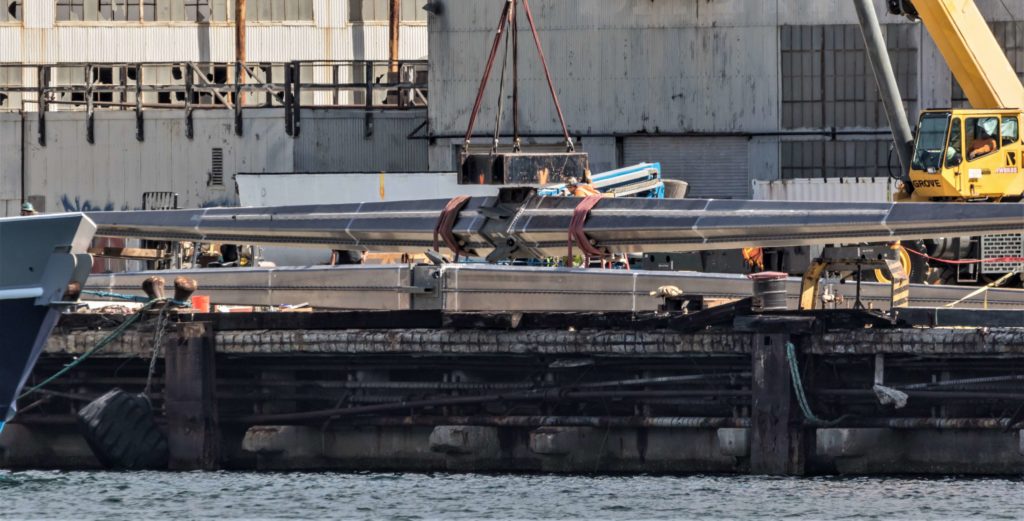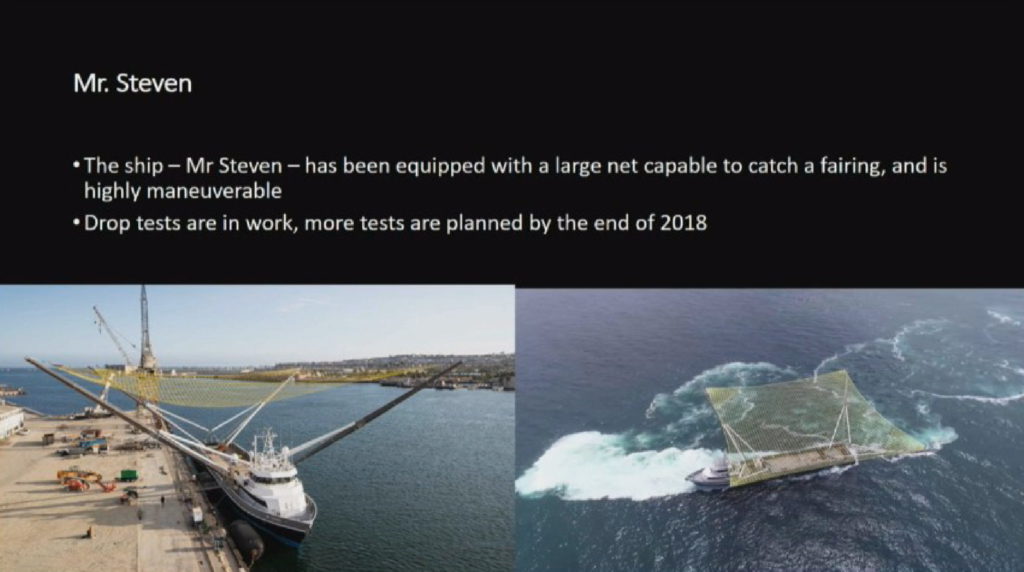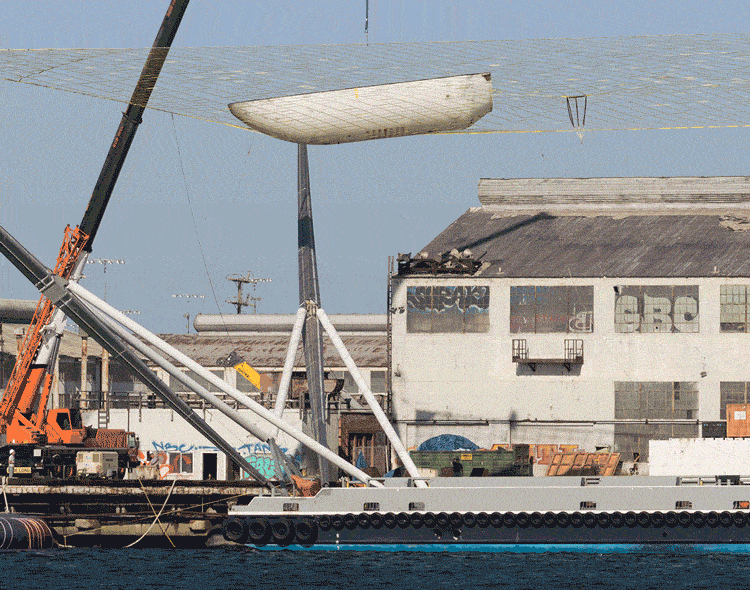

SpaceX
SpaceX reinstalls Mr Steven’s arms for Sunday Falcon 9 fairing catch
Over the course of less than half a day, SpaceX recovery technicians completed installation of three of Mr. Steven’s four fairing recovery arms, and the final arm and net are now set to be attached to the ship by the end of tomorrow, leaving plenty of time for Mr. Steven to attempt a Falcon fairing recovery this Sunday.
The reason for the delay is unclear, but SpaceX’s next launch and Mr. Steven’s next attempt at catching a Falcon fairing slipped 24 hours to 7:21 pm, October 7 (02:21 UTC, Oct. 8). Set to place Earth-observation satellite SAOCOM-1A into a low Earth orbit, this mission will mark SpaceX’s 16th reuse of Falcon 9 boosters in 18 months, as well as the operational debut of the company’s West Coast landing zone.
One of the ship’s 8 giant struts has been attached. There’s a good pace going so far. #spacex #mrsteven pic.twitter.com/8h73GoAztW
— Pauline Acalin (@w00ki33) October 3, 2018
Prior to attaching three arms and six of eight suspension booms, SpaceX’s recovery technicians spent the majority of October 1st and 2nd assembling Mr. Steven’s arms and situating them for installation, including the introduction of a new attachment jig of some sort. Likely used to safely rotate the arms into a position where traditional harnesses can then be used to lift them for installation, technicians spent several hours repeatedly picking up and setting down Mr Steven’s recovery components, swapping between the square jig and harnesses for each arm.
Additionally, a lone diver was spotted working near Mr. Steven’s stern off of a small utility boat equipped for underwater welding, presumably performing routine maintenance or repairs on the vessel’s hull and screws (propellers).
- The Marlin hovered around Mr Steven on the 1st and 2nd. (Pauline Acalin)
- A diver services Mr Steven. (Pauline Acalin)
- A curious jig used while preparing Mr Steven’s arms for installation, 10/02/18. (Pauline Acalin)
Once those various tasks were completed, SpaceX installed 3 of 4 arms over a period of roughly 8 hours on Wednesday, wrapping up around sunset after working through an unusual bout of rain in the Port of L.A. Despite having disappeared from Mr. Steven and Berth 240 for more than a month and a half, the vessel’s arms and booms appear almost entirely unchanged aside from visible shipping labels and the installation of small rings at the center of each arm, most likely a simple aid for organizing the rigging needed to operate his fairing catcher net.
In early August, SpaceX spent a day or two testing Mr. Steven’s arms and net with an actual Falcon fairing half, demonstrating just how flexible the combination can be. Along with motorized rigging, Mr. Steven can quickly and safely drop an ~800 kg fairing half onto its deck while also precisely controlling the net’s tension.
- A gif demonstrates just how taut Mr Steven’s net can be, thanks to mechanized rigging. 08/13/18 (Pauline Acalin)
Speaking on October 3rd, SpaceX VP of Build and Launch Reliability Hans Koenigsmann expressed confidence that SpaceX would be able to close the loop and begin recovering fairings soon, and confirmed that the company still plans to conduct controlled drop tests with fairings later this year while continuing to attempt to catch fairing halves after SpaceX’s Vandenberg launches. Overall, Koenigsmann was visibly excited about the successes SpaceX’s fairing recovery team have already secured.
Now targeting October 7 for launch of SAOCOM 1A. Rocket and payload are healthy; additional time will be used to complete pre-flight vehicle checkouts.
— SpaceX (@SpaceX) October 3, 2018
For prompt updates, on-the-ground perspectives, and unique glimpses of SpaceX’s rocket recovery fleet check out our brand new LaunchPad and LandingZone newsletters!

Elon Musk
Starlink passes 9 million active customers just weeks after hitting 8 million
The milestone highlights the accelerating growth of Starlink, which has now been adding over 20,000 new users per day.

SpaceX’s Starlink satellite internet service has continued its rapid global expansion, surpassing 9 million active customers just weeks after crossing the 8 million mark.
The milestone highlights the accelerating growth of Starlink, which has now been adding over 20,000 new users per day.
9 million customers
In a post on X, SpaceX stated that Starlink now serves over 9 million active users across 155 countries, territories, and markets. The company reached 8 million customers in early November, meaning it added roughly 1 million subscribers in under seven weeks, or about 21,275 new users on average per day.
“Starlink is connecting more than 9M active customers with high-speed internet across 155 countries, territories, and many other markets,” Starlink wrote in a post on its official X account. SpaceX President Gwynne Shotwell also celebrated the milestone on X. “A huge thank you to all of our customers and congrats to the Starlink team for such an incredible product,” she wrote.
That growth rate reflects both rising demand for broadband in underserved regions and Starlink’s expanding satellite constellation, which now includes more than 9,000 low-Earth-orbit satellites designed to deliver high-speed, low-latency internet worldwide.
Starlink’s momentum
Starlink’s momentum has been building up. SpaceX reported 4.6 million Starlink customers in December 2024, followed by 7 million by August 2025, and 8 million customers in November. Independent data also suggests Starlink usage is rising sharply, with Cloudflare reporting that global web traffic from Starlink users more than doubled in 2025, as noted in an Insider report.
Starlink’s momentum is increasingly tied to SpaceX’s broader financial outlook. Elon Musk has said the satellite network is “by far” the company’s largest revenue driver, and reports suggest SpaceX may be positioning itself for an initial public offering as soon as next year, with valuations estimated as high as $1.5 trillion. Musk has also suggested in the past that Starlink could have its own IPO in the future.
News
SpaceX shades airline for seeking contract with Amazon’s Starlink rival

SpaceX employees, including its CEO Elon Musk, shaded American Airlines on social media this past weekend due to the company’s reported talks with Amazon’s Starlink rival, Leo.
Starlink has been adopted by several airlines, including United Airlines, Qatar Airways, Hawaiian Airlines, WestJet, Air France, airBaltic, and others. It has gained notoriety as an extremely solid, dependable, and reliable option for airline travel, as traditional options frequently cause users to lose connection to the internet.
Many airlines have made the switch, while others continue to mull the options available to them. American Airlines is one of them.
A report from Bloomberg indicates the airline is thinking of going with a Starlink rival owned by Amazon, called Leo. It was previously referred to as Project Kuiper.
American CEO Robert Isom said (via Bloomberg):
“While there’s Starlink, there are other low-Earth-orbit satellite opportunities that we can look at. We’re making sure that American is going to have what our customers need.”
Isom also said American has been in touch with Amazon about installing Leo on its aircraft, but he would not reveal the status of any discussions with the company.
The report caught the attention of Michael Nicolls, the Vice President of Starlink Engineering at SpaceX, who said:
“Only fly on airlines with good connectivity… and only one source of good connectivity at the moment…”
CEO Elon Musk replied to Nicolls by stating that American Airlines risks losing “a lot of customers if their connectivity solution fails.”
American Airlines will lose a lot of customers if their connectivity solution fails
— Elon Musk (@elonmusk) December 14, 2025
There are over 8,000 Starlink satellites in orbit currently, offering internet coverage in over 150 countries and territories globally. SpaceX expands its array of satellites nearly every week with launches from California and Florida, aiming to offer internet access to everyone across the globe.
Currently, the company is focusing on expanding into new markets, such as Africa and Asia.
News
Tesla hints at Starlink integration with recent patent
“By employing polymer blends, some examples enable RF transmission from all the modules to satellites and other communication devices both inside and outside the vehicle.”

Tesla hinted at a potential Starlink internet terminal integration within its vehicles in a recent patent, which describes a vehicle roof assembly with integrated radio frequency (RF) transparency.
The patent, which is Pub. No U.S. 2025/0368267 describes a new vehicle roof that is made of RF-transparent polymer materials, allowing and “facilitating clear communication with external devices and satellites.”
Tesla believes that a new vehicle roof design, comprised of different materials than the standard metallic or glass elements used in cars today, would allow the company to integrate modern vehicular technologies, “particularly those requiring radio frequency transmission and reception.
Tesla has recently filed a US patent application on integrating RF transparent materials into the roof structure.
“facilitating clear communication with external devices and satellites”
Tesla fleet is getting @Starlink connectivity integration soon. LFG @Tesla @elonmusk… pic.twitter.com/bLa8YtPLd1
— Chansoo Byeon (@Chansoo) December 9, 2025
Instead of glass or metallic materials, Tesla says vehicles may benefit from high-strength polymer blends, such as Polycarbonate, Acrylonitrile Butadiene Styrene, or Acrylonitrile Styrene Acrylate.
These materials still provide ideal strength metrics for crashworthiness, stiffness for noise, vibration, and harshness control, and are compliant with head impact regulations.
They would also enable better performance with modern technologies, like internet terminals, which need an uninterrupted signal to satellites for maximum reception. Tesla writes in the patent:
“By employing polymer blends, some examples enable RF transmission from all the modules to satellites and other communication devices both inside and outside the vehicle.”

One of the challenges Tesla seems to be aware of with this type of roof design is the fact that it will still have to enable safety and keep that at the forefront of the design. As you can see in the illustration above, Tesla plans to use four layers to increase safety and rigidity, while also combating noise and vibration.
It notes in the patent that disclosed examples still meet the safety requirements outlined in the Federal Motor Vehicle Safety Standards (FMVSS).
Starlink integrated directly into Tesla vehicles would be a considerable advantage for owners. It would come with a handful of distinct advantages.
Initially, the inclusion of Starlink would completely eliminate cellular dead zones, something that is an issue, especially in rural areas. Starlink would provide connectivity in these remote regions and would ensure uninterrupted service during road trips and off-grid adventures.
It could also be a critical addition for Robotaxi, as it is crucial to have solid and reliable connectivity for remote monitoring and fleet management.
Starlink’s growing constellation, thanks to SpaceX’s routine and frequent launch schedule, will provide secure, stable, and reliable internet connectivity for Tesla vehicles.
Although many owners have already mounted Starlink Mini dishes under their glass roofs for a similar experience, it may be integrated directly into Teslas in the coming years, either as an upgrade or a standard feature.














